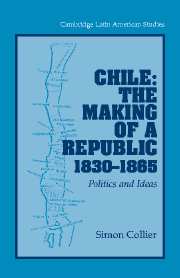Book contents
- Frontmatter
- Contents
- Acknowledgments
- Abbreviations Used in the Notes
- Introduction
- PART I THE NEW REPUBLIC, 1830–1865
- PART II FROM PORTALES TO MONTT, 1835–1851
- PART III MID-CENTURY ATTITUDES
- 5 Progress and Its Instruments
- 6 Political Argument
- 7 Model Republic
- 8 Looking Outward
- PART IV ORDER AND LIBERTY, 1851–1864
- Sources
- Index
8 - Looking Outward
Published online by Cambridge University Press: 24 July 2009
- Frontmatter
- Contents
- Acknowledgments
- Abbreviations Used in the Notes
- Introduction
- PART I THE NEW REPUBLIC, 1830–1865
- PART II FROM PORTALES TO MONTT, 1835–1851
- PART III MID-CENTURY ATTITUDES
- 5 Progress and Its Instruments
- 6 Political Argument
- 7 Model Republic
- 8 Looking Outward
- PART IV ORDER AND LIBERTY, 1851–1864
- Sources
- Index
Summary
Chile and the “Semisavage” Sister Republics
If the Araucanians were “savage” for educated Chileans of the early republic, their Latin American neighbors were at least “semisavage,” according to an 1850 news-sheet. Chileans' views of the other Latin American countries were invariably tinged by the superiority complex we have noted. Spanish America, for El Mercurio in 1841, was a “universal shipwreck … from Mexico to Buenos Aires,” and for a magazine of the following year, “a gladiatorial circus.” According to El Ferrocarril in 1859 (not a good year for Chilean boastfulness on this score), every steamship brought news of “revolutionary chaos” in the sister republics. The general perception was often confirmed by foreigners living in Chile. Sermonizing in Santiago cathedral during the dieciocho of 1854, an Ecuadorian priest drew a lurid picture of the sister states – “many … with more resources than you” – and the “stormy waves of anarchy” that battered them, not to mention their “nameless tyrants.” Father Noboa's point was fair. The other Spanish American republics were all passing through turbulent times, their histories regularly punctuated by palace revolutions, civil wars, regional struggles, dictatorial governments, and, in some cases, repressive atrocities that made Chile's Conservative regime seem a paragon of benevolence. Educated Chileans could read news reports from virtually every part of Latin America (although many more from Europe) in the press. Most of their attention (to judge from press articles and congressional debates) was focused on their immediate neighbors: Argentina, Peru, and Bolivia.
- Type
- Chapter
- Information
- Chile: The Making of a Republic, 1830–1865Politics and Ideas, pp. 167 - 188Publisher: Cambridge University PressPrint publication year: 2003

